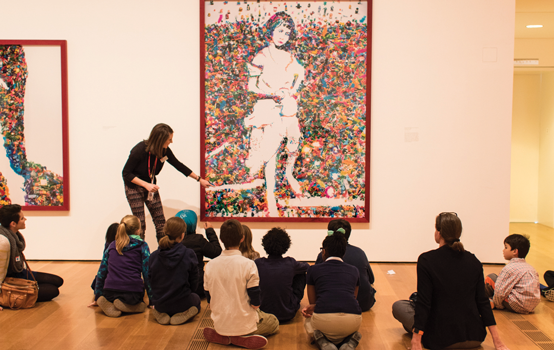Arts-based field trips can boost students’ academic performance, improve school engagement, and support social-emotional well-being.
We know that student learning is not confined to classrooms or the academic curriculum. Children are learning wherever they go, and schools can enhance student learning by providing a variety of experiences, whether through classes, extracurricular clubs, or social activities, that help them build skills and understanding in all kinds of areas that extend beyond academics. And sometimes nonacademic learning can fuel academic learning.
The near-term benefits of arts-based field trips, for example, have been well documented in previous studies. Students who participated in such field trips saw significant gains in social-emotional learning (Greene et al., 2018; Watson et al., 2019), including higher levels of tolerance, empathy, and social perspective taking, as well as academic gains (Erickson et al., 2019; Greene, Kisida, & Bowen, 2014). Notably, these benefits were most significant for students of color and students from less-advantaged backgrounds (Kisida, Greene, & Bowen, 2013).
In a recent study, Heidi Erickson, Angela Watson, and Jay Greene (2020) sought to find out what effects multiple arts-based field trips might have on students. This three-year investigation, conducted in partnership with the Woodruff Arts Center in Atlanta, Georgia, demonstrates that when students attend multiple field trips, many of the academic and social-emotional benefits endure for years.
Background of the study
The Woodruff Arts Center is home to three partners: Alliance Theatre, Atlanta Symphony Orchestra, and High Museum of Art. With more than 800,000 visitors each year, it is one of the largest arts centers in the country. It is also the No. 1 arts educator in Georgia, serving more than 135,000 students and more than 5,400 educators during the 2019-20 school year.
School districts in Metro Atlanta, where the arts center is located, face many challenges, including but not limited to students’ low scores on 3rd-grade reading and 8th-grade math proficiency tests. According to the Metro Atlanta Regional Education Partnership’s annual report (Learn4Life, 2020), only 44% of students in Metro Atlanta are reading on grade level when they reach 3rd grade, and children who have not developed reading skills by that time are four times more likely to drop out of high school. In addition, only 45% of 8th-grade students are proficient in math, a key gatekeeper to high school graduation.
In recent years, tightened budgets in the area have led schools, particularly those serving less-affluent students, to limit or cancel the number of annual field trips. To see what difference field trips might make for students, the Woodruff Arts Center enlisted a research team from the University of Arkansas to investigate the social-emotional and academic benefits of attending arts-based field trips. The participating school district already had an established and ever-deepening partnership with the Woodruff Arts Center and was even planning to become an arts-center district with arts-rich schools. This study would help both the Woodruff and the district address institutional priorities.
Study design
Over the course of three years, the researchers randomly assigned 2,100 4th and 5th graders from 15 elementary schools in the partner district to either a treatment group, which would take a field trip to each of the Woodruff Arts Center’s three Art Partners in a single school year, or to a control group, which would receive one arts-based field trip through their school’s regularly scheduled programming. That is, the study compared students who had multiple arts field trips to similar students who received only one.
Nearly all students in the 15 schools identify as Black or African American, and the majority of students in the study sample perform below grade level on the Georgia Milestones end-of-year exams. Also, 78% of students in the district are eligible for free or reduced-price lunch.
The field trips are all part of existing programming designed for young audiences at each of the three venues. Students experience an hour-long professional theater performance designed for children and families, a volunteer docent-led tour and a hands-on studio experience led by a teaching artist at the art museum, and an hour-long symphony concert paired with projected video descriptions and images. At the beginning of each school year during the study, teachers whose students were assigned to the treatment group (i.e., who would go on three field trips) participated in a full-day professional learning event facilitated by the Woodruff Arts Center, where they learned about the exhibitions, productions, and performances and about strategies to incorporate the experience into their classroom instruction.
Throughout the three consecutive years of the study, a subset of students received two back-to-back years of treatment. This enabled researchers to study the effect for students going on trips for just one year and for two consecutive years, as well as the effects one and two years after the trips.
To determine the effects of the trips, the study used two data sources: student surveys and district administrative data. Treatment and control students were surveyed at the beginning of the school year in students’ first year of the study to establish pretreatment measures, and follow-up surveys were administered at the end of each year of the study to collect post-treatment measures. The survey consisted of several scales used in previous arts field trip studies. These include measures of students’ tolerance, school engagement, social perspective taking, and desire to participate in and consume arts. Students were asked to choose their level of agreement to statements like these (used to measure students’ interest in consuming art):
- Visiting art museums is fun.
- I plan to go to orchestra music performances when I am an adult.
- I would tell my friends that they should see a live theater performance.
District administrative data provided additional information, including student demographics, course grades, standardized test scores, school attendance, and disciplinary infractions.
Results
Social-emotional effects. After one year of going on multiple field trips, students’ survey responses showed a greater desire to consume arts in the future and more agreement with the statement, “I believe people can have different opinions about the same thing” than control students (see Figure 1).

Academic effects. Test-score results showed positive outcomes of attending multiple trips that persisted even two years later. Students who attended all three field trips scored higher on their Georgia Milestones end-of-grade exams and earned higher course grades two years after the trips than did students in the control group (see Figure 2).
Behavioral effects. Significant effects of the field trips on student behavior were only evident one to two years after the trips, when the students entered middle school, and the effects only appeared in the first student cohort. When students from this first group entered middle school, they had fewer absences from school, and during the year after attending the field trips, they had fewer behavioral infractions than control group students. In addition, treatment students demonstrated less careless answering on the survey (see Figure 1), a measure designed to capture their level of conscientiousness while completing a school task. (This increase in school engagement may explain some of the improvement in academic outcomes.)
Teacher feedback. Teachers whose students went on multiple field trips had mainly positive impressions of the experience, including the professional development session held in advance of the trips. As one participating teacher commented, the session was “Relevant, engaging, necessary! I appreciated that these workshops were grounded in applicable strategies that we can take back to the classroom.” Teachers also remarked that the trips were potentially
“life changing” for some students and that students were inspired by the possibility of becoming artists themselves. They also expressed a desire to offer more trips in the future.

Photos courtesy of Woodruff Arts Center.
Policy implications and further study
The results of this study provide evidence that ongoing exposure to multiple, high-quality, arts-based field trips can benefit students’ academic progress, social-emotional well-being, and school engagement. This study also demonstrates that these benefits can persist even years after the trips.
The research team will continue collecting data on the students in this study over time to observe if these effects continue to persist more than two years after the field trips or if there are other observable effects as students enter middle and high school (such as whether they choose arts electives). A qualitative companion study is underway to better understand students’ and teachers’ experiences with arts-based field trips, to follow up a previous 2019 qualitative study by Angela Watson.
Schools that serve economically disadvantaged populations like those in this study are under constant pressure both to prepare all students for standardized tests and to help struggling students reach grade-level proficiency. These results suggest that non-academic learning opportunities, such as educational field trips, can not only support students’ social-emotional growth but may also help them become more engaged in school and potentially support long-term academic progress. Such experiences could also help students discover new avenues for expression, explore the world outside their neighborhoods, and make school more engaging. Students benefit from being presented a broad array of learning opportunities, whether they take place inside the classroom or in the community. Learning should not be confined to what happens in the classroom during the school day.
References
Erickson, H.H., Watson, A.R., & Greene, J.P. (2020). An experimental evaluation of arts field trips. (EDRE Working Paper No. 2020-03). Annenberg Institute at Brown University.
Erickson, H.H., Greene, J.P., Watson, A., & Beck, M.I. (2019). Does art make you smart? A longitudinal experiment of the effects of multiple arts-focused field trips (EDRE Working Paper 2019-05). University of Arkansas, Fayetteville.
Greene, J.P., Holmes, Erickson, H.H., Watson, A.R., & Beck, M.I. (2018). The play’s the thing: Experimentally examining the social and cognitive effects of school field trips to live theater performances. Educational Researcher, 47 (4), 246-254.
Greene, J.P., Kisida, B., & Bowen, D. (2014). The educational value of field trips. Education Next, 14 (1), 78-86.
Kisida, B., Greene, J.P., & Bowen, D.H. (2013, November 23). Art makes you smart. The New York Times, p. SR12.
Learn4Life. (2020). State of education in Metro Atlanta annual report 2020. Metro Atlanta Regional Education Partnership
Watson, A. (2019). Inside the black box: Stakeholder perceptions on the value of arts field trips (EDRE Working Paper No. 2019-14). University of Arkansas, Fayetteville.
Watson, A., Greene, J.P., Erickson, H.H., & Beck, M. (2019). Altered attitudes and actions: social-emotional effects of multiple arts field trips (EDRE Working Paper 2019-06). University of Arkansas, Fayetteville.
ABOUT THE AUTHORS

Jay P. Greene
JAY P. GREENE is the director of the National Endowment for the Arts Research Lab and a distinguished professor of education reform at the University of Arkansas, Fayetteville.

Laura Florick
LAURA FLORICK is a researcher at the National Endowment for the Arts Research Lab at the University of Arkansas, Fayetteville.

Rebecca Levenberg
REBECCA LEVENBERG is the director of foundations and grants at the Woodruff Arts Center in Atlanta, GA.

Rebecca Pogue
REBECCA POGUE is the head of elementary school programs at the Alliance Theatre in Atlanta, GA.










